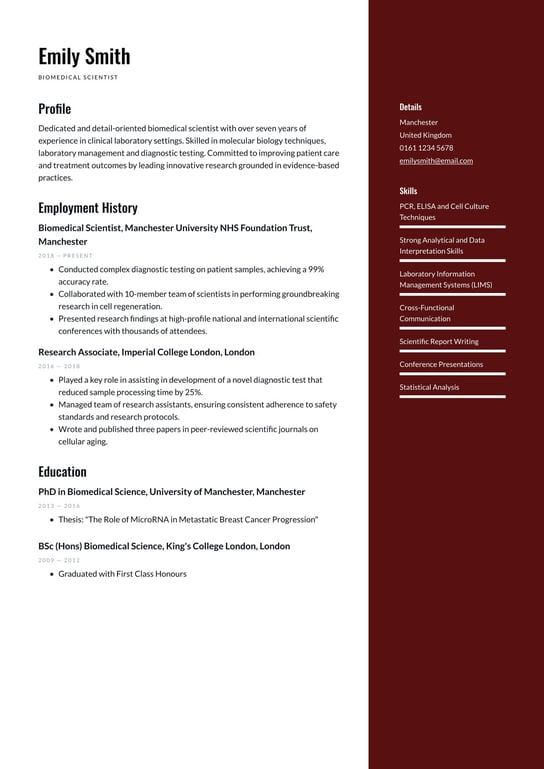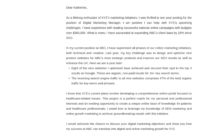Landing your dream job as a biomedical scientist can feel like navigating a complex maze. The competition is often fierce, and your CV is essentially your golden ticket, the first impression you make before an employer even meets you. It’s your chance to showcase your unique skills, experience, and passion for the field, but knowing how to present all that information effectively can be a real headache.
That’s where a well-structured CV comes in handy. Think of it as your personal marketing document, designed to highlight why you’re the perfect fit for that specific role. Instead of staring at a blank page, wondering where to begin, having a solid framework can guide you, ensuring you don’t miss any crucial details and present yourself in the best possible light. Let’s explore how you can build a compelling CV that truly stands out.
Crafting Your Biomedical Scientist CV: Essential Sections to Include
When you’re piecing together your CV, it’s not just about listing everything you’ve ever done. It’s about strategically organizing your information so that a busy recruiter can quickly grasp your value. A clear, logical flow makes your CV easy to read and ensures that your most impressive achievements are front and center. Think about it from their perspective: they’re looking for specific qualifications and experiences, and your job is to make those easy to find.
Your Personal Statement or Professional Summary
This is arguably one of the most vital parts of your CV. Placed at the very top, it’s a concise, powerful paragraph (or a few bullet points) that summarizes your career aspirations, key skills, and what you bring to the table. For a biomedical scientist, this is where you can immediately highlight your expertise in laboratory techniques, research methodologies, or diagnostic procedures. It should be tailored to each job application, acting as your elevator pitch to convince the employer to keep reading.
Education and Qualifications
As a biomedical scientist, your academic background is foundational. List your degrees, starting with the most recent. Include the institution, your major, graduation dates, and any significant achievements, like distinctions or specific research projects. If you’ve undertaken specialized modules or certifications relevant to the field, such as Good Clinical Practice (GCP) or specific laboratory accreditations, be sure to highlight them here. This section provides the bedrock of your scientific knowledge.

Professional Experience
This is where you bring your education to life with practical application. Detail your work history, starting with your most recent role. For each position, include your job title, the organization, and dates of employment. Crucially, use action verbs to describe your responsibilities and, wherever possible, quantify your achievements. Think about the specific laboratory techniques you’ve mastered, the types of samples you’ve analyzed, or the research projects you’ve contributed to. This is your chance to show the real-world impact of your work.
- Conducted PCR, ELISA, and cell culture experiments to support cancer research, contributing to a 15% increase in data collection efficiency.
- Processed and analyzed over 100 patient samples daily, ensuring accuracy and adherence to strict safety protocols.
- Managed inventory for a molecular diagnostics lab, reducing waste by 10% through optimized ordering.
- Trained junior staff on new laboratory equipment and standard operating procedures.
Key Skills and Competencies
This section is excellent for quickly showcasing your breadth of abilities. Divide your skills into technical/laboratory skills and transferable/soft skills. For technical skills, be specific: mention particular instruments you’ve used, software you’re proficient in (e.g., LIMS, statistical packages), and analytical techniques. For soft skills, think about teamwork, problem-solving, attention to detail, and communication, all vital in a scientific setting. This section, particularly in a cv template for biomedical scientist, acts as a quick reference for recruiters checking off essential requirements.
Making Your Biomedical Scientist CV Shine: Advanced Tips
Once you have your core sections in place, the next step is to refine your CV to ensure it truly stands out from the crowd. It’s not just about what you include, but also how you present it and how well it resonates with the specific role you’re applying for. A generic CV, no matter how comprehensive, often gets overlooked in favor of one that clearly demonstrates a perfect fit.
One of the most powerful strategies is to tailor your CV for every single job application. Read the job description carefully and identify the key skills, responsibilities, and qualifications they are looking for. Then, rephrase your experience and skills using the language from the job description. If they mention “flow cytometry,” ensure that term appears in your CV if you have experience with it. This isn’t about fabricating experience, but about highlighting your relevant skills in a way that directly addresses the employer’s needs. It shows you’ve done your homework and are genuinely interested in *their* specific role.
Another crucial tip is to quantify your achievements whenever possible. Instead of saying “managed lab equipment,” say “managed inventory and maintenance for 20+ pieces of critical lab equipment, reducing downtime by 25%.” Numbers add credibility and give recruiters a tangible sense of your impact. This can be challenging if your work doesn’t always lend itself to statistics, but think creatively: how many samples did you process? How many projects did you contribute to? Did your efforts save time or resources? Even approximate figures are better than none.
Finally, remember the power of proofreading. A single typo or grammatical error can undermine your professionalism and attention to detail, qualities that are highly valued in the scientific field. Read your CV aloud, or even better, ask a trusted colleague or friend to review it for you. A fresh pair of eyes can spot mistakes you might have overlooked. Ensure your formatting is consistent, clean, and easy to read; a cluttered or poorly organized CV can be just as off-putting as an error-filled one.
Your CV is a dynamic document, a living representation of your professional journey. It should evolve with your career, always reflecting your latest achievements and aspirations. By investing time in creating a comprehensive, well-structured, and targeted document, you significantly boost your chances of securing those coveted interview opportunities and stepping closer to your ideal role in biomedical science. Remember, every detail counts when you’re making that critical first impression.
Ultimately, a compelling CV opens doors. It’s the essential tool that bridges your skills and ambitions with the needs of potential employers, setting the stage for meaningful conversations and exciting career advancements. With a strong CV in hand, you’re not just applying for a job; you’re making a compelling case for your future.
